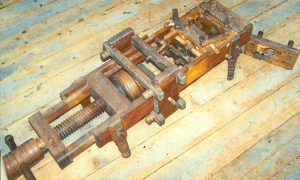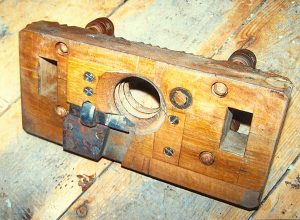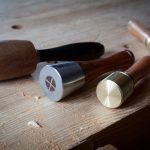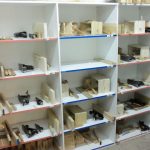We may receive a commission when you use our affiliate links. However, this does not impact our recommendations.
We recently received a letter about and pictures of a vintage threading machine from a New York reader who asked if we knew anything about. We don’t – nor do any of my go-to sources. But I’ll bet some of you can help. If so, please leave responses below, and I’ll print them and mail them to the reader (or perhaps he’ll see them here). And if not, well, the pictures are just interesting to ponder (click on the images below to make them larger).
 Please find enclosed some pictures of an old spindle threading machine evidently made by a very adept craftsman. As you can see, there are many wooden threaded thumbscrews that allow for infinite adjustment with all components of the machine. Cutters are located at the entrance and exit of the “cutter box.” The main frame slides in and out on heavy rails and there is a separate frame that must have held some kind of additional cutters or cleaners.
Please find enclosed some pictures of an old spindle threading machine evidently made by a very adept craftsman. As you can see, there are many wooden threaded thumbscrews that allow for infinite adjustment with all components of the machine. Cutters are located at the entrance and exit of the “cutter box.” The main frame slides in and out on heavy rails and there is a separate frame that must have held some kind of additional cutters or cleaners.
I thought it might be for making bench vice screws, but it looks like it has only about a 10″ throw.
 I am helping a neighbor set up an old woodworking and farming museum and would appreciate any help you may forward to me.
I am helping a neighbor set up an old woodworking and farming museum and would appreciate any help you may forward to me.
Malcolm Bancroft
Here are some supplies and tools we find essential in our everyday work around the shop. We may receive a commission from sales referred by our links; however, we have carefully selected these products for their usefulness and quality.











Seeing this item I thought I would ask Stuart King if he could throw any light on the subject as he is one of the UK’s foremost experts on antiquated wood working equipment and also a well known international wood turner, here is his response.
” What a beautifully constructed tool/machine, I have never seen such a device before and it looks like a one-off item, the overall look of the piece to me is of something mid 19th century or earlier.
One would not construct such a tool (except as a personal challenge) to do just a few treaded spindles so I would think that it was designed to produce quite large numbers of spindles with a standard pitch dictated by the pitch of the feed screw. The diameter of the spindle could be varied by introducing a different ‘cutter box’ at the end.
What is not shown in the images is the complete face of the lead screw, I would expect this to have some means of locating the spindle as it would need to revolve as it moved forward, maybe there in a square recess in the face, this would give a positive hold?
Now his response does not clear up who made it but it throws some light on the fact it was made for a special purpose.
For more information on Stuart visit http://www.stuartking.co.uk/
It looks like it might be designed to thread male and female threads. The smaller frame could hold a blank for a nut, which is threaded by a cutter driven by the “bench screw” at one end. It would be helpful to see a better view of the disk on the end of that screw, which I take to be some form of chuck. The other end of the machine holds a screw box for cutting the bench screws, either driven by hand from the outside or from the far end by the same screw and chuck which holds the internal cutter for nuts. Does that make sense, or is it just screwy?
Whoever made this was obviously rather pleased with his ability to make screw fasteners!
I remember my grand-dad had one of these in his workshop.It was used for putting threads on wooden spindles (dowels).The threaded dowels were used to put furniture together using in joints where nails would not be strong enough.
That is such a fascinating instrument. As an engineer and woodworker, I am in awe of the workmanship on that piece.